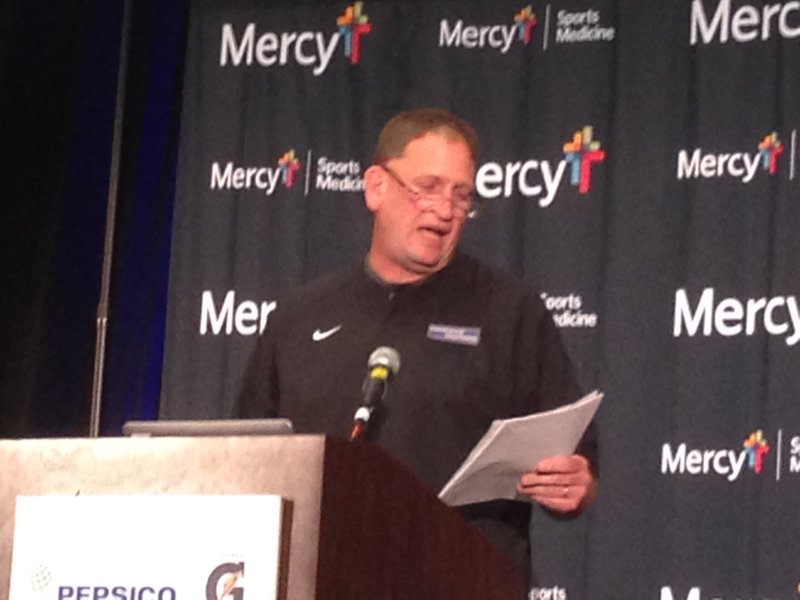ROGERS -- Athletes who specialize in one sport at an early age are more likely to burn out or get injured, said Rob Miller, the Director of Proactive Coaching.
Miller was a guest speaker at the fifth annual Mercy Coaching Summit on Thursday at the John Q. Hammons Center. He referenced a study by Ohio State University that revealed young athletes who focus on just one sport "are 70 to 90 percent more likely to get injured than those who play multiple sports."
Miller's address centered on the myths and realities of specialization, and the former coach made it clear he was an advocate of athletes playing multiple sports.
"We have to come to the realization that whether it's clubs, schools or whatever, this is about our young people," Miller said. "Seventy-four percent of all kids are done with sports by the time they are 13 years old. Three out of four are done by the age of 13. Our best kids may not even get to junior high because they are done.
"We are burning them out. We're starting them earlier, they're playing all year long, they're getting tired."
Miller said he has seen first-hand how young players are laying down their bats or hanging up their cleats well before they reach high school age.
"My daughter quit playing soccer at age 13," he said. "By the time she was 13, she had played more organized soccer games than I had played organized basketball when I played my first college basketball game."
Tony Travis, who was named the Rogers Heritage football coach earlier this year after seven seasons at Class 4A Pea Ridge, said he encourages athletes to participate in more sports. He pointed out that athletes at smaller schools tend to play multiple sports, but he also wants to encourage his football players at Class 7A Heritage to do the same.
"My personal belief is, if a kid wants to be a multi-sport athlete, then it's my job as a football coach to make sure that's possible for them," Travis said. "I value them as a football player, but if he's on the basketball team, I have to value him as a basketball player, too.
"If I'm truly in it for his best interest, I have to value him as a basketball player or a baseball player or a wrestler or whatever it might be."
Miller said the sports culture is different than it was 30 years ago. He said more television exposure and an increase in club sports have had a dramatic effect on young athletes.
He related a story about his business partner who was a high school athlete. One day he came home and complained to his father about not getting enough playing time. When he finished, his father looked at him and said, "work harder."
"That doesn't happen today," Miller said.
Greg White, the new boys basketball coach at Bentonville West after coming over from Gravette, said coaches should encourage their athletes to play multiple sports.
White mentioned a former athlete at Gravette as a prime example of a player who participated in virtually every sport the school had to offer.
"Coming from Gravette, a kid like Jackson Soule', he's just a ballplayer," White said. "He was the best player in every sport. Typically if they are good in one sport, they are going to be good in the other sports, too."
White said often the players won't approach the coaches about playing more than one sport because they think the coaches are not willing to share them.
"They'll use that as an excuse," he said. "Everyone wants what's best for their program, but we have to become better at what's best for the player."
Miller said there has been a 60-percent increase in girls club sports over the past 15 years. He also said the average cost for an athlete in club volleyball is $4,000 per year.
Youth sports are no longer the neighborhood kids playing in the local baseball league. He cited a recent study that showed Myrtle Beach, S.C., brings in more than $100 million annually from youth sporting events, and that nationwide, youth sports is a $5 billion per year industry.
White, the basketball coach, said even his own sport needs to do a better job of making sure athletes have down time away from the court.
"You've got guys playing 60 basketball games in the summer. That's too much," he said. "We have a limit as a high school team for a reason.
"I think the big key is, you want kids to be kids. We tell our guys, 'look, you get one shot to be a high school athlete. Go do everything you can.'"
Sports on 07/30/2016

